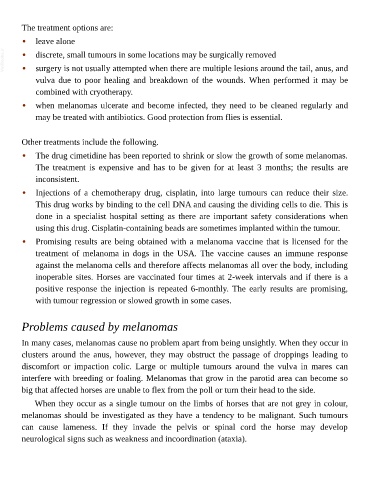Page 898 - The Veterinary Care of the Horse
P. 898
The treatment options are:
• leave alone
VetBooks.ir • discrete, small tumours in some locations may be surgically removed
•
surgery is not usually attempted when there are multiple lesions around the tail, anus, and
vulva due to poor healing and breakdown of the wounds. When performed it may be
combined with cryotherapy.
• when melanomas ulcerate and become infected, they need to be cleaned regularly and
may be treated with antibiotics. Good protection from flies is essential.
Other treatments include the following.
• The drug cimetidine has been reported to shrink or slow the growth of some melanomas.
The treatment is expensive and has to be given for at least 3 months; the results are
inconsistent.
• Injections of a chemotherapy drug, cisplatin, into large tumours can reduce their size.
This drug works by binding to the cell DNA and causing the dividing cells to die. This is
done in a specialist hospital setting as there are important safety considerations when
using this drug. Cisplatin-containing beads are sometimes implanted within the tumour.
• Promising results are being obtained with a melanoma vaccine that is licensed for the
treatment of melanoma in dogs in the USA. The vaccine causes an immune response
against the melanoma cells and therefore affects melanomas all over the body, including
inoperable sites. Horses are vaccinated four times at 2-week intervals and if there is a
positive response the injection is repeated 6-monthly. The early results are promising,
with tumour regression or slowed growth in some cases.
Problems caused by melanomas
In many cases, melanomas cause no problem apart from being unsightly. When they occur in
clusters around the anus, however, they may obstruct the passage of droppings leading to
discomfort or impaction colic. Large or multiple tumours around the vulva in mares can
interfere with breeding or foaling. Melanomas that grow in the parotid area can become so
big that affected horses are unable to flex from the poll or turn their head to the side.
When they occur as a single tumour on the limbs of horses that are not grey in colour,
melanomas should be investigated as they have a tendency to be malignant. Such tumours
can cause lameness. If they invade the pelvis or spinal cord the horse may develop
neurological signs such as weakness and incoordination (ataxia).

